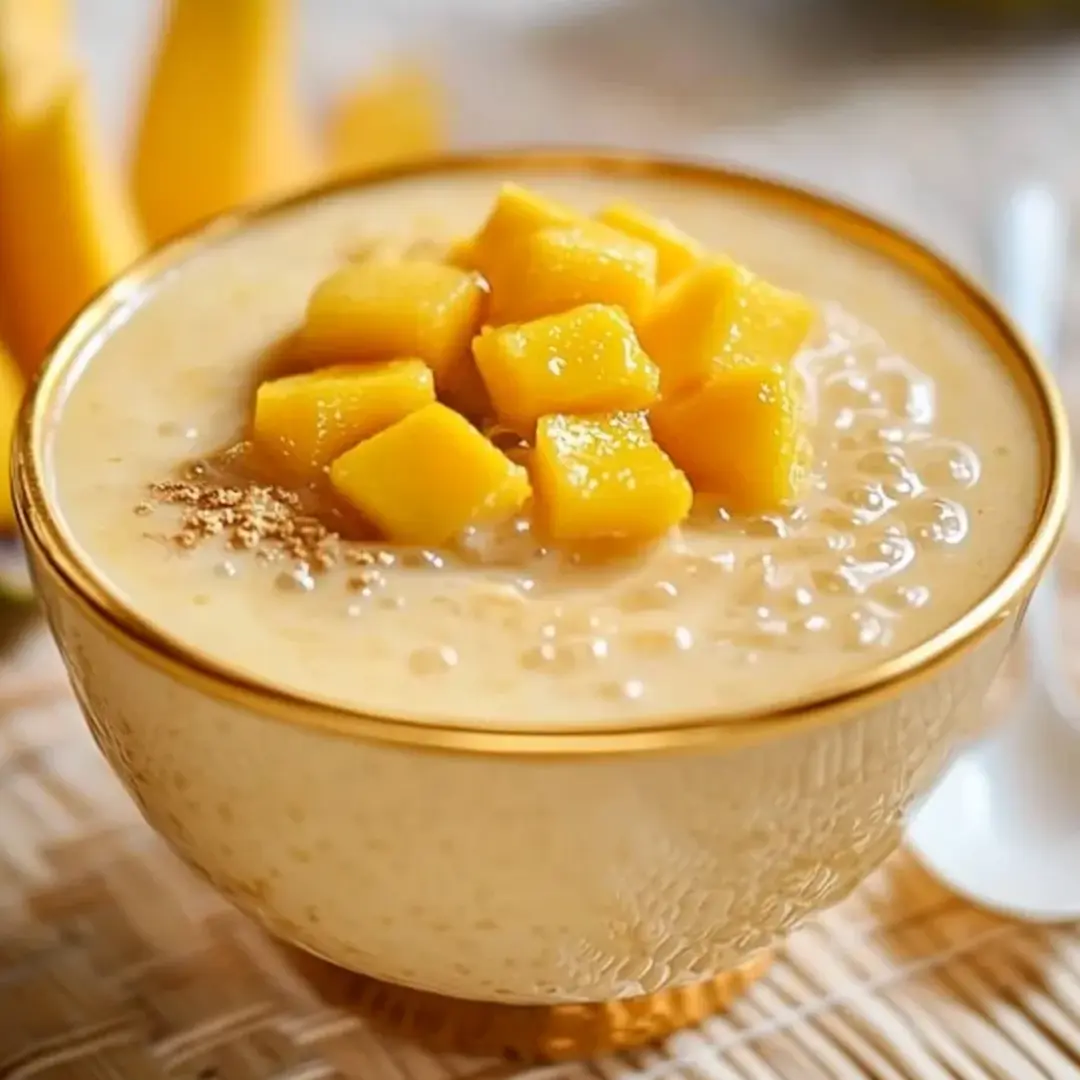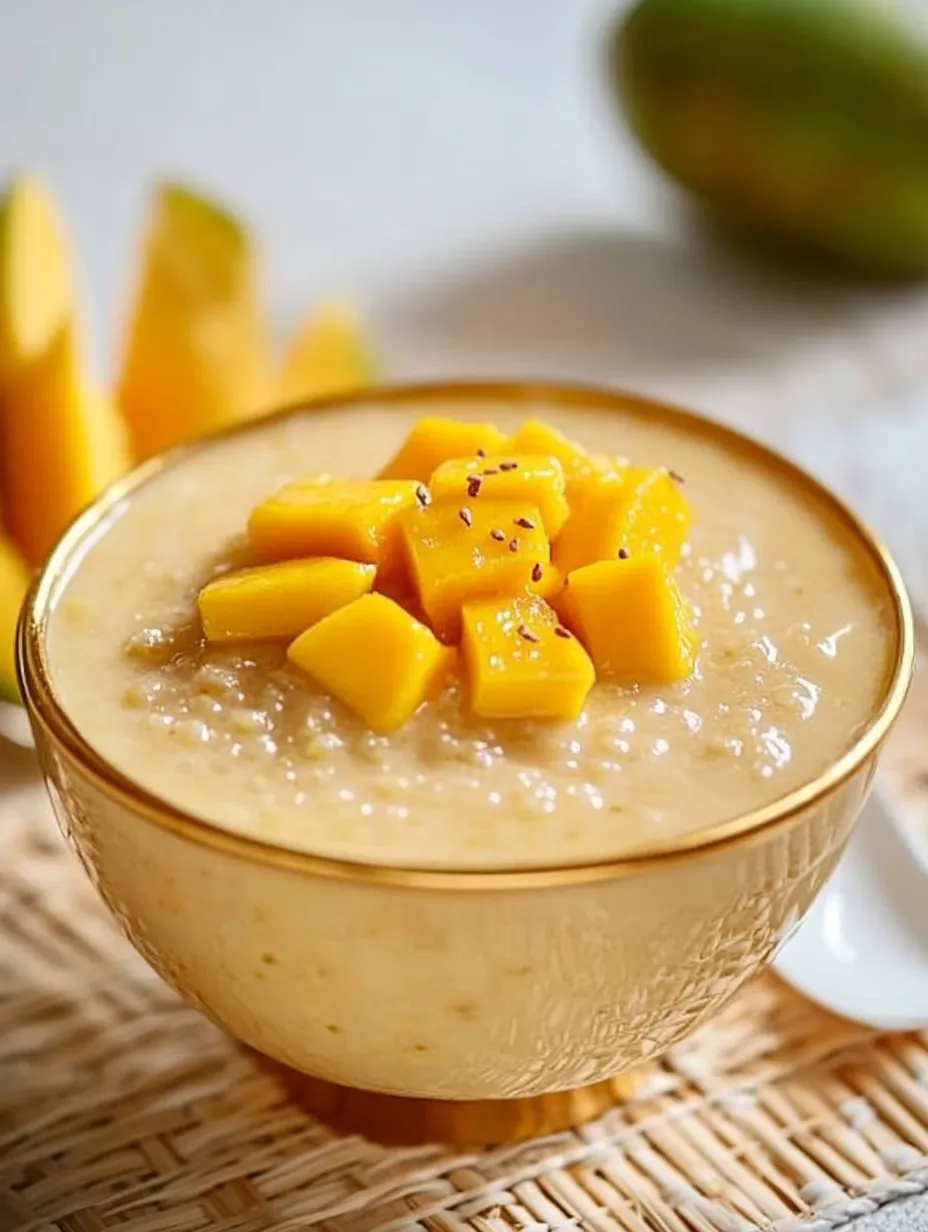 Pin it
Pin it
Mango Sago brings together the sweet tropical flavor of ripe mangoes with the delightful chewiness of tiny tapioca pearls, all swimming in a creamy coconut milk base. This vibrant dessert offers the perfect balance of texture and taste that makes it impossible to resist, especially during hot summer days. The touch of condensed milk adds just the right amount of sweetness that ties all the flavors together in this Asian-inspired treat.
I made this for a backyard gathering last weekend and my neighbors couldn't believe how something so simple could taste so exotic. The little tapioca pearls were a hit - everyone kept asking what those delightful chewy bits were!
Ingredients
- Ripe mangoes: Look for mangoes that yield slightly to gentle pressure and have a sweet fruity smell at the stem. Alfonso or Ataulfo varieties offer the most intense flavor and smooth texture without fibrous strings.
- Mini pearl tapioca: These tiny white pearls become translucent when cooked properly. Find them in Asian markets or online - don't substitute with larger tapioca pearls as they require different cooking methods.
- Coconut milk: Full-fat coconut milk creates the creamiest base, but you can use light coconut milk if preferred. The quality matters here, so choose brands without unnecessary additives.
- Condensed milk: This sweet, thick milk adds richness and silky texture. The distinctive flavor cannot be perfectly replicated, though simple syrup or agave work as vegan alternatives.
- Vanilla extract: A touch of vanilla rounds out the tropical flavors and adds depth. Pure extract rather than artificial flavoring makes a noticeable difference.
- Water: For cooking the tapioca pearls. Filtered water ensures no unpleasant flavors interfere with the delicate dessert.
 Pin it
Pin it
Step-by-Step Instructions
- Step 1:
- Prepare your cooking area properly - Start by measuring out all your ingredients and having them ready to go. This is especially important for the tapioca pearls since timing is crucial for their preparation. Have a fine-mesh strainer ready near your stove for draining the cooked pearls. I like to fill a medium-sized bowl with cold water in advance so it's ready for soaking the pearls after cooking.
- Step 2:
- Cook the tapioca correctly - Bring exactly 4 cups of water to a vigorous, rolling boil in a medium pot. It's essential that the water is fully boiling before adding the tapioca - this ensures even cooking and prevents clumping. Once boiling, add your mini pearl tapioca while stirring gently with a wooden spoon to prevent the pearls from sticking to the bottom of the pot. After the water returns to a boil, reduce the heat to maintain a steady simmer rather than a violent boil which could break up the delicate pearls.
- Step 3:
- Monitor the cooking process carefully - Simmer the tapioca for 20 minutes, stirring occasionally to prevent sticking. The pearls will gradually change from white opaque balls to translucent ones. You'll notice this change starting from the outside of each pearl moving inward. The key indicator of doneness is when no white centers remain in the pearls - they should be completely clear, like little glass beads. If after 20 minutes you still see white centers, turn off the heat, cover the pot, and let them continue cooking in the residual heat for another 10 minutes.
- Step 4:
- Cool and preserve the texture - Once fully cooked, drain the pearls immediately in your fine-mesh strainer and rinse with cold water to stop the cooking process. This cooling step is crucial as it sets the texture of the pearls and prevents them from becoming mushy. Transfer the cooled pearls to your bowl of cold water to keep them from sticking together. They can remain in this water until you're ready to assemble your dessert.
- Step 5:
- Prepare the mangoes with care - Select ripe, fragrant mangoes for the best flavor. To peel, stand the mango on its end and use a sharp knife to slice downward, following the curve of the fruit to remove the skin. Once peeled, slice the mango flesh away from the pit in large pieces. Set aside some attractive chunks for topping, approximately one-third of your mango. These presentation pieces should be cut into uniform bite-sized cubes that will look appealing when served.
- Step 6:
- Create the silky base mixture - In your blender, combine the coconut milk, condensed milk, vanilla extract, and the remaining two-thirds of your mango pieces. Blend until completely smooth, taking care to process long enough to eliminate any fibrous mango bits. The resulting mixture should have a velvety consistency and uniform color. If your mango wasn't quite sweet enough, you can adjust with a little extra condensed milk at this stage.
- Step 7:
- Chill for optimal flavor development - Transfer the blended mango mixture to a large bowl and refrigerate for at least one hour before serving. This chilling time allows the flavors to meld together and intensify. Remember that cold temperatures dull sweetness slightly, so if you plan to serve your dessert very cold, you might want to make the base a touch sweeter than seems necessary at room temperature.
- Step 8:
- Assemble just before serving - When ready to serve, portion the mango mixture into individual serving bowls. Drain the soaked tapioca pearls thoroughly and gently fold them into each bowl of mango mixture. The pearls should be evenly distributed throughout the dessert. Top each serving with your reserved mango chunks, arranging them attractively on the surface.
The Art of Choosing Mangoes
The success of this dessert hinges largely on selecting perfectly ripe mangoes. When shopping, don't just look at the color - some varieties remain green even when ripe. Instead, gently squeeze the mango; it should yield slightly to pressure, similar to a ripe avocado. The aroma at the stem end should be sweet and fragrant. If possible, choose mangoes that have been ripened naturally rather than gas-ripened, as they develop more complex flavors.
The Cultural Significance of Sago
This dessert has its roots in Southeast Asian cuisine, particularly in Hong Kong, Singapore, and Malaysian food cultures. The combination of tropical fruits with tapioca (called sago in some regions) represents the clever use of abundant local ingredients. What began as humble street food has evolved into a beloved dessert served in homes and upscale restaurants alike, speaking to its universal appeal across economic and cultural boundaries.
Tapioca: The Tiny Pearl with a Big Impact
The mini tapioca pearls in this dessert might seem like a minor ingredient, but they contribute significantly to what makes Mango Sago special. These pearls are made from cassava root starch and offer a uniquely chewy texture that Japanese cuisine calls "mochi-mochi" - a pleasant bounciness that contrasts beautifully with the smooth mango puree. This textural contrast is what elevates simple ingredients into a memorable dessert experience.
 Pin it
Pin it
The Perfect Summer Gathering Dessert
What makes Mango Sago particularly suited for entertaining is its make-ahead nature. The components can be prepared a day in advance and assembled just before serving. This allows hosts to focus on other aspects of entertaining without sacrificing an impressive dessert option. It's also surprisingly portable, making it ideal for potlucks or picnics when stored in sealed containers.
A Versatile Base for Creativity
While traditional Mango Sago is delicious as is, this recipe provides a wonderful foundation for personalization. Some home cooks incorporate other tropical fruits like passionfruit or lychee, while others add textural elements like grass jelly or aloe vera. The basic technique remains the same, allowing for seasonal adaptations throughout the year when mangoes might not be at their peak.
I've always had a special connection to coconut milk desserts since my grandmother would make them for special occasions. The first time I combined it with fresh mango, I was amazed at how two simple ingredients could create something that tasted so much more complex than the sum of its parts. Now it's my go-to impressive dessert that never fails to delight guests.
This Mango Sago dessert has become one of my most requested recipes, especially during summer gatherings. There's something magical about the way the creamy coconut milk complements the bright, tropical mango flavor. I love watching people's expressions when they take their first spoonful and discover the delightful chewy surprise of the tapioca pearls. It reminds me of the simple joy good food can bring - transforming ordinary moments into little celebrations. Whether you're serving this after a spicy meal or as a light afternoon treat, it never fails to transport you to a beachside paradise, if only for a few blissful bites.
Frequently Asked Questions
- → Can I use frozen mango instead of fresh?
- Yes, thawed frozen mango works well in this recipe, though fresh mango gives the best flavor and texture for the chunks on top.
- → How long can I store mango sago in the refrigerator?
- You can store it for up to 2 days in the refrigerator, though the tapioca may absorb more liquid and become softer.
- → Can I make this dessert dairy-free?
- Yes, substitute the condensed milk with coconut condensed milk or a dairy-free sweetener like maple syrup or sugar.
- → What type of mango works best for this recipe?
- Sweet, ripe varieties like Alphonso, Ataulfo (honey mango), or Manila mangoes work wonderfully in this dessert.
- → Where can I find small tapioca pearls?
- Small tapioca pearls can be found in Asian grocery stores, international food sections of supermarkets, or online.
